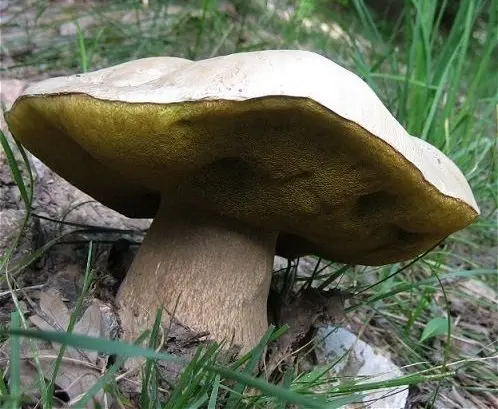Boletus barrowsii (Boletus barrowsii)
- Division: Basidiomycota (Basidiomycetes)
- Subdivision: Agaricomycotina (Agaricomycetes)
- Class: Agaricomycetes (Agaricomycetes)
- Subclass: Agaricomycetidae (Agaricomycetes)
- Order: Boletales (Boletales)
- Family: Boletaceae (Boletaceae)
- Genus: Boletus
- Type: Boletus barrowsii (Boletus Burrows)

Description:
The hat is large, fleshy and can reach 7 – 25 cm in diameter. The shape varies from flat to convex depending on the age of the mushroom – in young mushrooms, the cap, as a rule, has a more rounded shape, and becomes flat as it grows. Skin color can also vary from all shades of white to yellow-brown or gray. The top layer of the cap is dry.
The stem of the mushroom is 10 to 25 cm high and 2 to 4 cm thick, club-shaped and light whitish in color. The surface of the leg is covered with a whitish mesh.
The pulp has a dense structure and a pleasant sweetish taste with a rather strong mushroom smell. The color of the pulp is white and does not change or darken when cut.
The hymenophore is tubular and can be either attached to the stem or squeezed from it. The thickness of the tubular layer is usually 2-3 cm. With age, the tubules darken slightly and change color from white to yellowish green.
The spore powder is olive brown. Spores are fusiform, 14 x 4,5 microns.
Burroughs’ boletus is harvested in the summer – from June to August.
Spread:
It is predominantly found in the forests of North America, where it forms mycorrhiza with coniferous and deciduous trees. In Europe, this species of boletus has not been found. Burroughs’ boletus grows randomly in small groups or large clusters.

Related types:
Burroughs’ boletus is very similar to the valuable edible porcini mushroom, which can be visually distinguished by its darker color and white streaks on the surface of the mushroom stem.
Nutritional qualities:
Like the white mushroom, Burroughs’ boletus is edible, but less valuable and belongs to the second category of edible mushrooms. A wide variety of dishes are prepared from this mushroom: soups, sauces, roasts and additions to side dishes. Also, Burroughs’ mushroom can be dried, because there is little moisture in its pulp.









